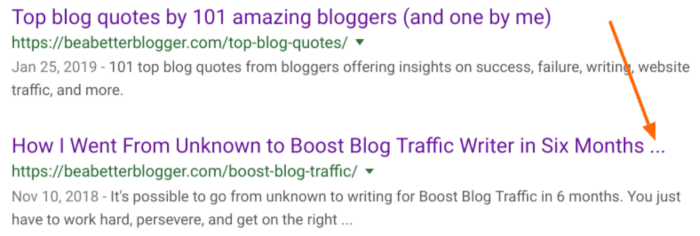
Here’s the thing:
There are many tutorials that can teach you how to write a blog post.
They can educate you on the mechanics of blogging, what to do, and what not to do.
Read them and you can learn how to craft a perfectly serviceable blog post. Heck, you might even write something that wins you an adoring fan or two.
But if you dream bigger, if you want to know how to write a blog post that cuts through the noise and wins you legions of fans, you need something better than a run-of-the-mill tutorial.
You need an ultimate guide.
In this post, this ultimate guide, we’ll share tips used by professional writers to create spellbinding posts that are adored by thousands. You’ll learn the secrets to crafting irresistible headlines, seducing introductions, captivating advice, and motivational closings.
You’ll even learn how the pros refine and polish their posts once they’re finished writing them.
These are secrets many bloggers would gladly pay real money to learn, but it won’t cost you a thing — other than a few minutes of your time.
Let’s dive in.
Want Smart Blogger’s Ultimate Editing Checklist — a 22-point cheatsheet for polishing your post to perfection? Click here to download it for free. Table of Contents Step #1. Craft a Headline That Readers Can’t Resist Step #2. Write an Introduction That Grabs and Seduces Step #3. Deliver Advice That’s Easy to Consume and Impossible to Ignore Step #4. Close with a Motivational Bang Step #5. Polish Your Post So It’s Smoother Than a Slip ‘n Slide Back to Top Step #1. Craft a Headline That Readers Can’t Resist 
Want to know one of the biggest mistakes bloggers make?
Writing the blog post before the headline.
Without a headline, they have no roadmap to follow. And so their post goes in multiple directions, leaving readers feeling dizzy, confused and disoriented.
And then they try to create a headline that embraces all that madness. Bloggers, have mercy!
If you want to write a blog post full of clarity, conciseness and conviction, spend some time crafting a quality headline that sets a clear destination, lures readers in, and leaves them eager for your advice.
Your headline will be your map, your writing navigation system, letting you know which literary roads to choose and which to avoid so that readers reach the intended destination as easily and efficiently as possible.
Follow these 8 rules to craft your killer headline:
Headline Rule #1. Pick a Mouth-Watering Topic
Want your blog post to get opened?
Then your headline must promise readers the very answer to whatever is tormenting them. The thing that keeps them up at night.
Your headline should not promise them a trip to the moon and back — readers are way too swift for such shenanigans. Keep the benefit specific and narrow, and readers will feel compelled to click and get the solution to what’s bugging them.
How do you find out what’s bugging your readers? Research:
Review comments on your posts and on posts of other sites in your niche. Send your subscribers surveys asking them what their greatest struggles are. Use tools like BuzzSumo to find out what the most popular posts in your niche are (which gives insight into your target readers’ needs). Read the reviews of books in your niche on Amazon (you’ll find a gold mine of feedback to explore).
You have one responsibility as a blogger — yup, just one. And that is to serve your audience. The better you know them, the better you serve.
Before you know it, you’ll know them so intimately they’ll feel like you’re reading their minds, and your headlines will reflect that.
Example:
Let’s say you’re in the self-improvement space and you wrote the headline below:
How to Create an Amazing Life
This headline is so broad it’s unlikely to draw readers in. No one loses sleep over “wanting to create an amazing life.” They lose sleep over specific aspects of their lives that have left them unfulfilled.
So you are better off narrowing in on something specific that’s bugging your readers, such as:
How to Boldly Pursue Your Dreams Even if You’re Scared and Insecure
Narrowing in on something specific makes readers feel like you have the answers they’re looking for.
Headline Rule #2. Steal from the Pros
Okay, you’ve done your research and you know exactly what your readers need. Now it’s time to turn your topic into into a killer headline.
The easiest way to master the art of writing headlines? Steal.
Not in the unethical way. In the smart and efficient way.
Decades of copywriting and advertising research have revealed the types of headlines that have proven to be successful. The types of headlines that zap readers out of their info-overload comas and compel them to open. Why mess with that research?
If you want your headlines to grab readers, stick with what works.
No, your headlines don’t need to sound like they came straight from BuzzFeed. They can reflect your voice and style.
But until you’re as skilled a writer as Jon Morrow, let the proven templates be your guide (how do you think he got so good at writing headlines?).
Blogging is hard enough, so if you have templates at your fingertips, why not use them?
The easiest templates to start with? “How to” headlines and list post headlines. They are classics and they work. In fact, 75% of Smart Blogger’s most popular posts use these formats.
Examples:
Here are a number of Smart Blogger headlines that follow the “how to” and list post templates.
“How to” Headlines:
How to Start a Blog in 2019: Research Reveals 20X Faster Method How to Make Money Writing: 5 Ways to Get Paid to Write in 2019 How to Make Money Blogging (Free Guide for 2019)
List Post Headlines:
21 Dumb Mistakes to Avoid When Writing Your First E-book The 5 Best Free Blogging Platforms in 2019 (100% Unbiased) Writer’s Block: 27 Ways to Overcome It Forever Note: You can download Jon’s free 52 Headline Hacks, where you’ll find more template options than you’ll ever need. Headline Rule #3. Engage Your Senses
Vague headlines leave readers feeling empty. Tangible headlines leave them feeling understood.
How to you create tangible headlines? Put yourself in the shoes of your reader.
How do they feel? What do they see, taste, or smell? What do they hear?
Engage all of your senses. The more your headline gives voice to their exact experience, the more they’ll feel like your post was written for them.
Example:
Let’s say you blog about health and wellness and you wrote a headline called:
5 Steps to Take When a Migraine Hits
This headline follows a proven list post formula, and it narrows in on something that’s bugging readers. All in all it’s not too bad, but it could be even more concrete.
To step it up a notch, put yourselves in the shoes of your readers. Think about exactly what they’re experiencing.
Perhaps that would lead you to the following:
5 Ways to Soothe Pounding and Blinding Migraines
If you suffer from migraines, there’s no way you could resist clicking such a headline.
Headline Rule #4. Tease, Don’t Satisfy
A common mistake you may not even realize you’re making?
Giving away too much in your headlines.
Your headlines should lure readers in like a literary temptress. They should catch readers’ attention and invoke their curiosity, not give a solution.
Give a solution in your headline and readers feel no need to go any further — they’re bored by the very thought of your post.
When this happens, not only do you lose but your readers lose as well, as they trade the richness of your post’s advice for the quick fix offered by the headline.
Example:
Let’s say you blog about personal finance and you write the headline below:
How to Save for Retirement by Creating a Monthly Budget
Sadly, readers will see this and think they’ve got all the advice they need — if they want to save for retirement, they must create a monthly budget. No need to read more.
On the other hand, a possible revision could be:
How to Save for Retirement When You’re Living Paycheck to Paycheck
For anyone living paycheck to paycheck, this headline would pique their curiosity. Nothing is given away, it speaks to an audience with a very specific problem, and it promises a solution they’d love to get their hands on.
Headline Rule #5. Honor the Headline Commandment
When it comes to headlines, there is only one commandment you can never break:
“Thou shalt not deceive.”
This may seem obvious, but writers inadvertently do it all the time. How?
They over-promise.
Big no-no. The content of your post must fully deliver on exactly what the headline promises.
If the post only delivers part of the solution, readers will feel misled and lose their trust in you.
Let’s never do that to them, yes?
Examples:
Let’s say you write a post called:
How to Live a Happy and Peaceful Life
But then the post only talks about following your dreams, which is really only one aspect of living a happy and peaceful life. Even though you didn’t intentionally deceive them, readers will feel shortchanged.
Another example — perhaps you write a post called:
5 Killer Ways to Attract New Clients to Your Coaching Business
But then the fifth way contains no useful advice and instead leads to a sales page to get the solution … no bueno.
Headline Rule #6. Trim the Fat
Want to overwhelm readers right from the start?
Fill your headline with weak and flabby words.
What are weak and flabby words? Empty, unnecessary words that add no real value. Instead, they create clunky phrasing and leave readers scratching their heads in confusion.
The mistake many bloggers make is writing headlines the way they speak. While that’s okay when you write the post (to a certain extent), when you write headlines that way it waters them down.
You want your headlines to be as ruthlessly concise and powerful as possible. So chop out weak words and throw in power words (if appropriate).
Examples:
Let’s say you draft the following headline:
How to Find It In Your Heart to Forgive Someone Even if They’ve Hurt You Really Badly
There are just so many words! We can cut them down as follows:
How to Forgive Someone Who Hurt You Badly
We can then add some power to it:
How to Forgive a Soul-Crushing Betrayal
Much better.
Another Example:
Here’s a mouthful:
How to Stop Being Overly Doubtful of Yourself So You Can Finally Begin to Pursue Your Wildest Dreams
My head is spinning. This can be cut down to:
How to Stop Doubting Yourself and Pursue Your Wildest Dreams
We could even make it more tangible and powerful:
How to End Paralyzing Doubts and Conquer Your Wildest Dreams
Nice and trim, but packs a punch.
Headline Rule #7. Don’t Be a Smarty-Pants
Your headline should make sense to all readers no matter where they’re coming from or in what context they’re approaching your post.
They shouldn’t have to guess what the benefit is. After all, you’re supposed to be reading their minds, not the other way around.
So you’ll want to avoid using metaphors (unless their meaning is painfully obvious), jargon, rhymes, made-up terms, or anything that tries to be overly clever or complicated when drafting your headlines.
Examples:
Where to begin with this one:
How to Be Happy Without Acting Sappy
A headline like this tries to be too clever — readers don’t give two hoots about not acting sappy, obviously. Don’t prioritize cute tactics like rhyming over delivering clear benefits in your headlines.
How to Raise a Child That Is the Apple of Your Eye
A headline like this is also trying to be too clever. “Apple of Your Eye” is a common metaphor readers are likely familiar with, but there’s no concrete benefit being offered here. A headline must always contain a strong benefit, not a cute phrase.
How to Follow the Path of Glory to Your Success
No clue what this means … and I just wrote it. If there isn’t a singular and clear interpretation of what the headline’s benefit is, it’s trying too hard. So save the metaphors for the actual post where they will (hopefully) make more sense.
How to Stop Treating Love Like a Captive Animal
Perhaps you effectively explain in the post how people treat love like a captive animal, and it may make for a great analogy, but readers scanning headlines will have no clue why they should stop to read this, and so they likely won’t.
Headline Rule #8. Rock Your Style
The more consistent you are with your audience, the more trust they’ll feel for you.
If you generally keep your headlines pretty simple and then suddenly write one jam-packed with power words, your readers will feel confused.
The more you write, the more of a style you’ll develop. Once you determine what that style is, use it consistently (or make slow and gradual changes to it if necessary) so your audience learns and trusts your brand.
Example:
If most of your headlines read like this:
How to Live With Courage How to Overcome Social Anxiety How to Confidently Embrace Uncertainty
Then you might not want to suddenly write a headline that reads:
How to Brazenly Squash the Agonizing Anxiety That Is Plaguing Your Life
Your readers will think your blog got hacked!
How to Write a Headline: Bonus Tip
When writing a headline, try crafting 5–10 different versions of the same headline.
The more you play with the words, the better you will get at creating clear, concise and curiosity-invoking headlines that readers cannot resist.
Editor’s Note:
I’d be remiss if I didn’t discuss a question we hear often:
“How long/short should my headline be?”
Ever notice how some headlines in SERPs (search engine results pages) are truncated?

It’s based on your headline’s width in pixels, but as a general rule: right round 60 characters Google will cut off your headline.
Since a truncated headline can result in fewer people clicking your link in SERPs, it’s a common SEO practice to keep your headlines 60 characters or less.
Of course, things are never that easy.
In a recent study, Brian Dean of Backlinko found that longer (14-17 words) headlines generated more shares on social media than shorter headlines.
(76.7% more social shares, to be exact.)
As with all things, your mileage may vary.
Back to Top Step #2. Write an Introduction That Grabs and Seduces 
You’ve lured readers in with your headline. Now you’ve got to keep them.
No easy task, my friend.
Readers are fickle. Known to take a quick glance and then vanish from your online sanctuary, lickety-split!
You must fight to keep them there, and the way you craft your introduction plays a huge role in their browsing commitment.
Follow these rules to craft an introduction that captivates your readers:
Introduction Rule #1. Slip into Their Shoes
A common mistake that reeks of amateur blogging?
Trying to sound too academic in your blog openings.
You know, those posts that start like this:
“Research has proven that 92% of people fail to achieve their goals because they are unable to create and stick to habits that support those goals …”
Don’t get me wrong — as a lawyer, I value solid research. But in the blogging context, this approach bores readers. If you want to captivate instead of bore, you must make readers feel like you’re reading their minds.
A powerful way to achieve this?
Empathy.
Step into their shoes and write from their perspective. Show them you understand exactly what they’re going through.
After all, you likely struggled with the very topic you’re writing about and learned how to overcome it. We teach what we most wanted to learn, right?
So show readers that you “get it.” You’re not some corporate slog, you’re in it with them, fighting the good fight and sharing the tools that brought you to the other side.
Example:
This introduction is a masterclass in empathy:
Do you feel that?
That little tugging sensation on your heart?
You’re not sure what, but something is pulling you to change. Not in a confess-your-sins-oh-ye-sinners way, but to shift directions, to embrace your calling, to finally do what you were put here to do:
Write.
You feel the ideas inside you. You sense them straining to escape. You know your job is to set them free, firing them like a cannon into a world in desperate need of them.
But you’re afraid.
You’re afraid of quitting your job and living without a safety net. You’re afraid of the concerned, disapproving looks your friends will give you when you tell them you’re giving it all up to write for a living. You’re afraid of not having enough money for food, of the power being cut off, of watching your family shivering and hungry, all because of your “selfishness”.
And most of all?
You’re afraid you’re wrong about yourself.
As writers, we all share the deep longing to embrace our calling and express our ideas, but we also share the fears that so often sabotage those longings — the fear that we don’t have what it takes, that we’ll crash and burn, and that our dreams are just that — dreams.
In his introduction, Jon addresses all those longings and fears and immediately makes you feel like he gets you so intimately, it’s almost creepy.
Creepy, but effective.
Note: You don’t need to open like this in every post. There are certainly other approaches, like telling a powerful story. But if you’re working on mastering your craft and getting the most impact for time invested, an empathetic opening is an approach you’ll want to use frequently. Introduction Rule #2. Get into Character
If you want to captivate readers, you must trigger their emotions.
So as you sit down to write, think of the feelings you want them to experience:
Fear, anger, sadness, hope, joy, disgust, shame, comfort, love, courage, and so on.
Then get into character and feel them yourself as you write, and your words will read with undeniable authenticity.
When Lin-Manuel Miranda wrote the heartbreaking lyrics in Hamilton that have left tears on the faces of millions, it was his eyes that first shed tears as he put his pen to paper.
So play with your emotions. Map out the emotional journey you’re taking readers on, and infuse those feelings into your writing. Feel what you want your audience to feel and your words will exude those emotions.
This tip applies to your whole post, but in no place is triggering your audience’s emotions more important than your introduction.
You feel me? 🙂
Example:
I once wrote an emotional post about my two little girls which addressed how delicate their emotions are, as well as my own vulnerabilities and my longing to give them the patience, presence and love they deserve.
Here’s a portion of it:
I told my three-year old daughter as we stood outside the car in her school parking lot, the rain pouring down on us as she..
Read more: smartblogger.com
